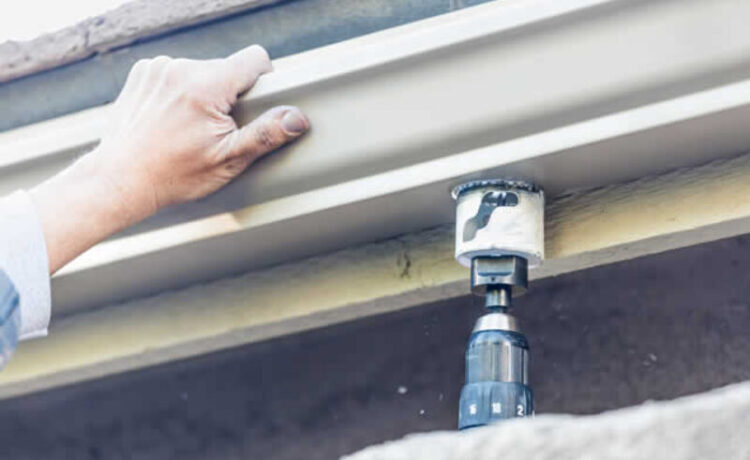Did you know that improper gutter installation can lead to water damage, foundation issues, and even pest infestations in your home? Understanding the key steps and techniques for a successful gutter installation is essential in safeguarding your property against these potential risks. By mastering the art of gutter installation, you not only protect your home but also enhance its overall value. So, are you ready to take on the challenge of installing your own gutters and ensuring the protection of your home for years to come?
Materials and Tools Needed
To start your gutter installation project, gather the necessary materials and tools for the job. Safety precautions are vital when working on elevated surfaces. Make sure you have sturdy ladders, fall protection gear, and a reliable helper to assist you.
Cost considerations play an important role in the selection of materials. Opting for high-quality gutters and downspouts might have a higher upfront cost but can save you money in the long run by reducing maintenance and potential replacements. Moreover, you’ll need gutter hangers, screws, sealant, and a level to ensure a proper installation.
Investing in quality tools and materials from the outset will result in a durable and efficient gutter system for your home.
Choosing the Right Gutter Type
When considering the right gutter type for your installation project, assess the specific needs of your home and the prevailing weather conditions in your area.
Aluminum gutters are popular due to their durability and cost-effectiveness. They come in a variety of color options to match your home’s exterior.
If you’re looking for a more aesthetically pleasing option, copper gutters offer a sophisticated look but come at a higher cost.
Vinyl gutters are another budget-friendly choice, but they may not be as durable in harsh weather conditions.
Stainless steel gutters are known for their strength and resistance to rust, making them suitable for areas with extreme weather.
Consider all factors, including cost comparison, aesthetic appeal, and durability when selecting the right gutter type for your home.
Measuring and Planning Your Installation
Begin your gutter installation project by meticulously measuring and planning each aspect of the layout to guarantee a precise and efficient installation process.
To start, make sure you determine the proper slope for your gutters. A recommended slope is 1/4 inch for every 10 feet of gutter. This slope allows water to flow effectively towards the downspouts and prevents water from pooling.
Next, accurately measure the gutter size needed for your installation. This involves measuring the length of your roofline and considering factors such as the average rainfall in your area to determine the appropriate capacity for the gutters.
Step-by-Step Installation Instructions
Make sure that you have all the necessary materials and tools ready before commencing the installation process for your gutters.
To start, verify the fascia boards are in good condition and secure.
Begin by attaching the gutter hangers every 24 to 36 inches, making sure they’re sloped at a proper angle for efficient drainage.
Next, connect the gutter sections, ensuring they form a seamless design to prevent leaks.
Secure the corners and end caps using sealant to maintain the integrity of the system.
Finally, test the gutter system by pouring water into it and adjusting the slope if necessary to ensure proper drainage.
Following these steps will help you install your gutters effectively.
Tips for Ensuring Proper Drainage
Maximize drainage by adjusting the gutter slope to direct water towards the downspouts effectively. Important slope is essential for ensuring water flows smoothly, preventing standing water that could lead to damage or leaks.
To achieve this, guarantee a downward slope of at least ¼ inch for every 10 feet of gutter. This angle helps water move efficiently towards the downspouts.
Furthermore, preventing clogs is vital for maintaining proper drainage. Install gutter guards or screens to keep debris out and regularly clean your gutters to remove any buildup.
Maintenance and Troubleshooting Tips
To keep your gutters functioning at their best and avoid potential issues, regular maintenance and troubleshooting are key aspects of gutter care. When it comes to cleaning techniques, it’s important to remove debris such as leaves and twigs regularly. Clogged gutters can lead to water overflow, causing damage to your home’s foundation.
Common problems to watch out for include leaks at the joints, sagging gutters, and rust. For seasonal maintenance, make sure to inspect and clean your gutters at least twice a year, especially before the rainy season. DIY solutions like using a gutter scoop or pressure washer can help you effectively clean out debris.
Conclusion
As you admire the smooth flow of rainwater cascading down your newly installed gutters, you can take pride in the skill and knowledge you’ve gained from this ultimate guide.
With each drop that’s efficiently channeled away from your home, you’re protecting its foundation and ensuring its longevity.
Embrace the satisfaction of a job well done and the peace of mind that comes with a properly installed gutter system.
Need help? Get an expert like grizzlybrothersgutters.com.







